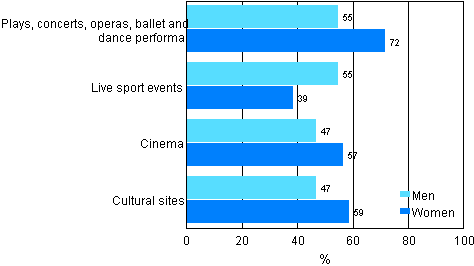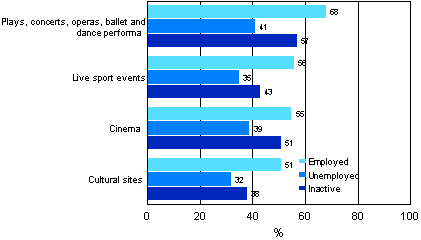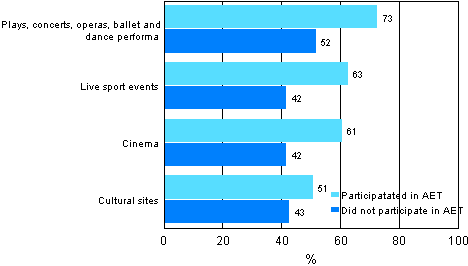Attendance of performances, exhibitions and sports events
Learning new things often also takes place at diverse shows, exhibitions and sports events. Attendance of such events can be learning-oriented so that the original motive for visiting them was to learn something new. Naturally, learning also takes place otherwise in their context as so-called incidental learning.
Number of attendants and frequency of attendance
Almost two out of three of the population aged between 25 and 64 in Finland had been to the theatre, a concert, the opera, ballet or dance performance in the course of the year in 2006 (Table 1). Good one-third had attended such events 1-3 times. More than half of the population aged 25 to 64 had been to the cinema at least once and one in three 1-3 times during the year. About the same number had visited museums and art exhibitions. Under one-half of the population of this age had attended sports events during the past 12 months.
The group having attended sports competitions or events contained the largest number of active persons who attended such events at least 12 times during the year. Their share among all persons having attended sports events was 11 per cent. Only a couple of per cent of the attendants of other events and exhibitions were this active.
Table 1. Attendance of diverse events, performances and exhibitions during the year in 2006 (population aged 25 to 64), %
| Event | Number of visits, % | |||||
| No visits | 1-3 times | 4-6 times | 7-12 times | More than 12 times | Total | |
| Plays, concerts, operas, ballet and dance performance | 36 | 39 | 14 | 7 | 4 | 100 |
| Cinema | 47 | 37 | 10 | 3 | 2 | 100 |
| Cultural sites | 48 | 34 | 11 | 5 | 2 | 100 |
| Live sport events | 53 | 24 | 9 | 5 | 11 | 100 |
Impact of gender on attendance of cultural and sports events
Nearly six out of ten, or about 59 per cent, of women aged between 25 and 64 participated in adult education and training in 2006. Men’s participation rate was clearly lower (47%) in this age group. Women also attended cultural events more actively than men (Figure 1). While nearly three out of four women between the ages of 25 and 64 had been to the theatre, a concert, the opera, ballet or a dance performance during the year, good one-half of men of the same age group had attended these events. Around six women in ten had visited museums, art exhibitions and the cinema. Around ten percentage points fewer men had attended these events. By contrast, men liked sports competitions and events, and about 55 per cent of men had attended them in the course of the year. The respective share was 16 percentage points lower among women.
Figure 1. Attendance of various events during the year by gender in 2006 (population aged 25 to 64)

Impact of age on attendance of cultural and sports events
People in the younger age group of 25 to 44 participated in adult education and training more during the year than their seniors in the 45 to 64 age group. Around six out of ten of them participated in adult education and training while slightly fewer (56%) of those between the ages of 45 and 54 did so. Fewer than four out of ten of the oldest examined age group of 55 to 64 participated in adult education. However, the impact of age on the attendance of diverse cultural events is not quite as clear as this, although certain differences by age group can be detected.
Age has a linear effect on a person’s cinema attendance; the younger a person the more often he/she goes to the cinema. Around seven out of ten of the youngest examined age group of 25 to 34-year-olds had been to the cinema at least once during the year. Of the 35 to 44 age group around six out of ten, of those aged 45 to 54 under one-half and of the oldest group of 55 to 64-year-olds only about one in three had been to the cinema. The share of persons having been to the cinema more than 12 times during the year was also the highest in the youngest age group (5%). Among their senior age groups the share of such very active cinema-goers ranged from one to three per cent.
Age also influences the number and frequency of attendance of sports events. The share having attended sports events was the highest in the 35-44 age group, of whom 56 per cent had attended at least one sports event during the year. More than one in two persons in the youngest age group had also been to some sports event. The two oldest age groups contained clearly fewer persons who had attended sports events: around 46 per cent in the 45-54 age group and even ten percentage points less than this in the 55-64 age group. The number having attended sports events more than 12 times in the past year was also the highest in the 35-44 age group (15% of the age group). There were fewer than one in ten (9%) of these very active followers of sports events among people younger than this, in the 45-54 age group their share was about 12 per cent while only seven per cent of the 55-64 age group had been to at least 12 sports events during the year.
Age did not have a statistically significant correlation with attendance of theatre, concerts, opera, ballet or dance performances.
Impact of labour market status on attendance of cultural and sports events
In 2006, employed persons aged 25 to 64 participated in adult education and training clearly more than unemployed persons and persons not in the labour force. Whereas roughly six out of ten of them participated in adult education the respective ratio among unemployed persons and persons not in the labour force was only one in three. Employed persons between the ages of 25 and 64 had also attended shows, exhibitions and sports events more frequently than unemployed persons and persons outside the labour force in the same age group (Figure 2), although especially compared to persons outside the labour force the difference was not quite so clear. For example, whereas two out of three employed persons had attended the theatre, a concert, the opera, ballet or a dance performance during the year, the respective ratios were under six out of ten among persons outside the labour force and around four out of ten among unemployed persons. The same trend can also be observed in respect of other events: employed persons are the most active, persons outside the labour force come second, and unemployed persons third.
Figure 2. Attendance of various events during the year by labour market status in 2006 (population aged 25 to 64)

Participation in adult education and training and attendance of cultural and sports events
Participants in adult education and training during the year had attended various cultural and sports events more frequently than non-participants (Figure 3). The differences in favour of the participants are very clear. In attendance of various cultural events and going to the cinema the difference in favour of participants in adult education and training was around 20 percentage points. One out of two of those having participated in adult education and training had attended sports competitions or events while the respective share was just short of ten percentage point smaller among non-participants in adult education and training.
Figure 3. Attendance of various events during the year by participation and non-participation in adult education and training (AET) in 2006 (population aged 25 to 64)

Source: Adult Education Survey 2006
Inquiries: Timo Ruuskanen (09) 1734 3620, Irja Blomqvist (09) 1734 3221, aikuiskoulutus.tilastot@stat.fi
Director in charge: Riitta Harala
Updated 4.2.2010
Official Statistics of Finland (OSF):
Participation in adult education [e-publication].
ISSN=2489-6926. Participation in cultural and sports events in Finland 2006,
Attendance of performances, exhibitions and sports events
. Helsinki: Statistics Finland [referred: 9.12.2025].
Access method: http://stat.fi/til/aku/2006/05/aku_2006_05_2010-02-04_kat_001_en.html

